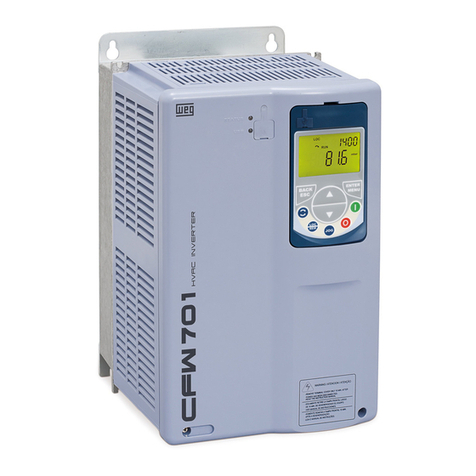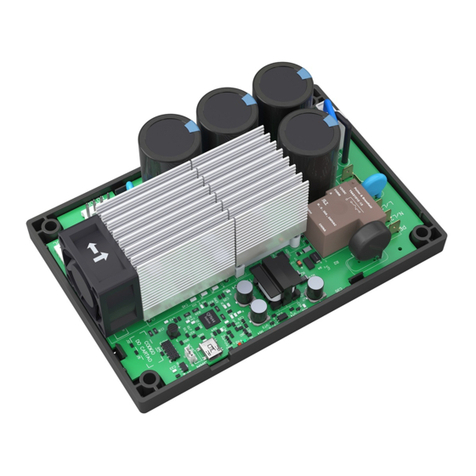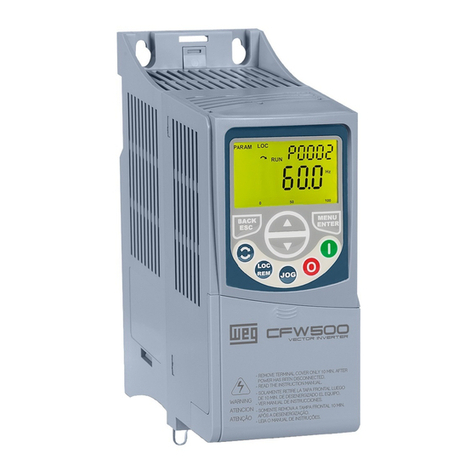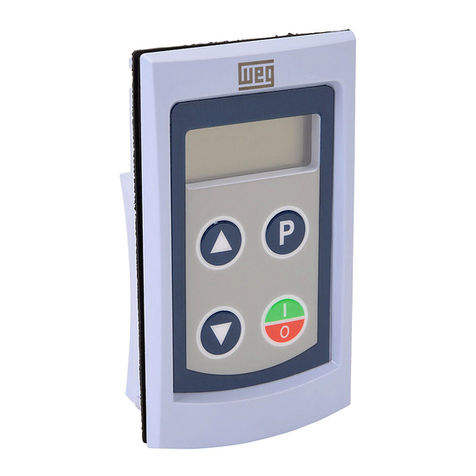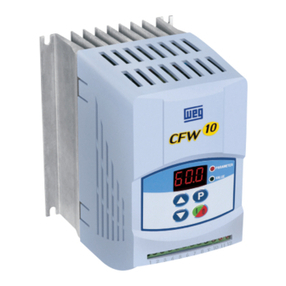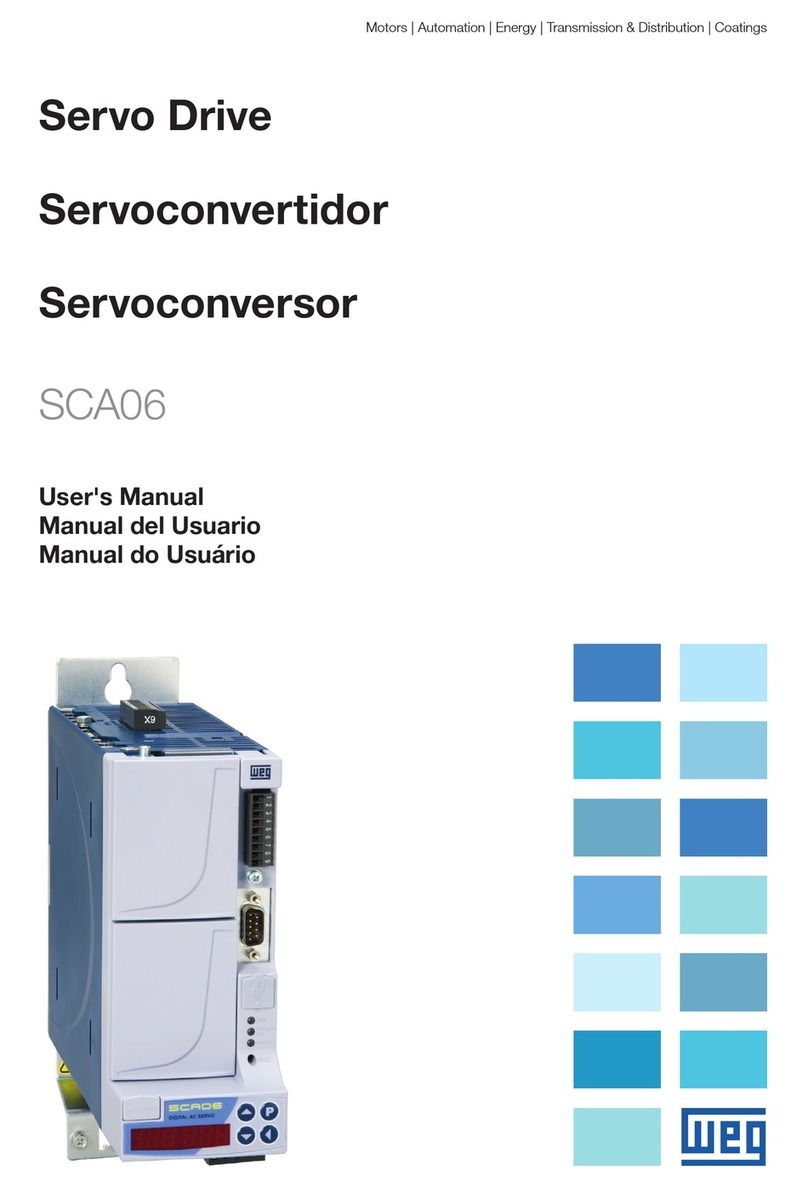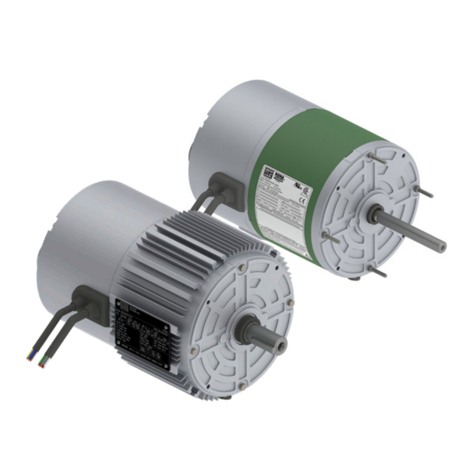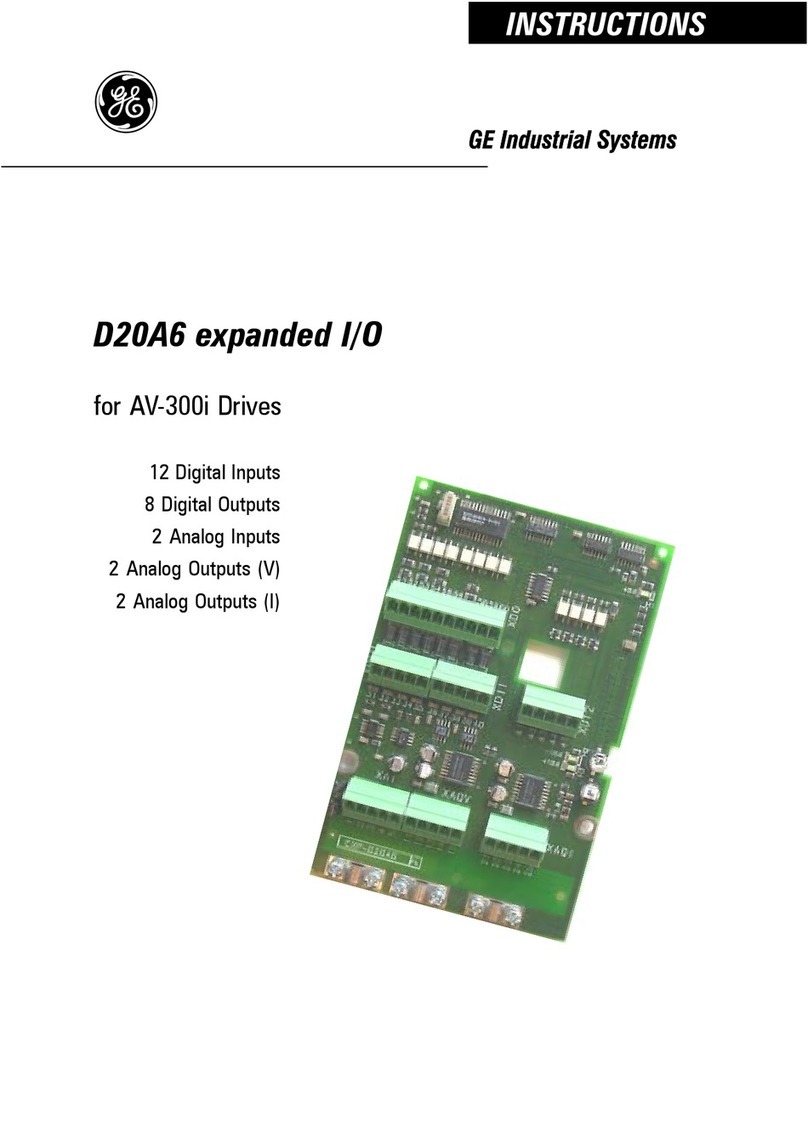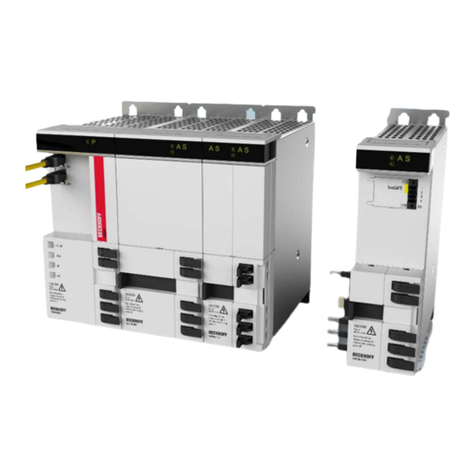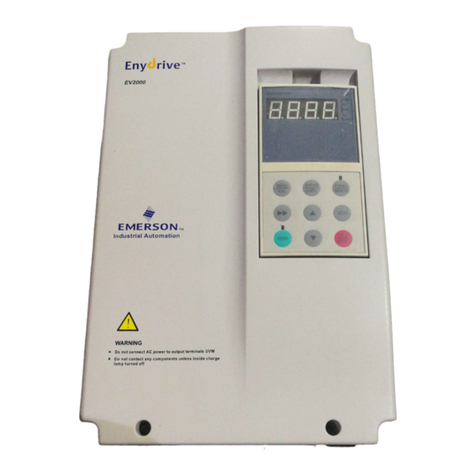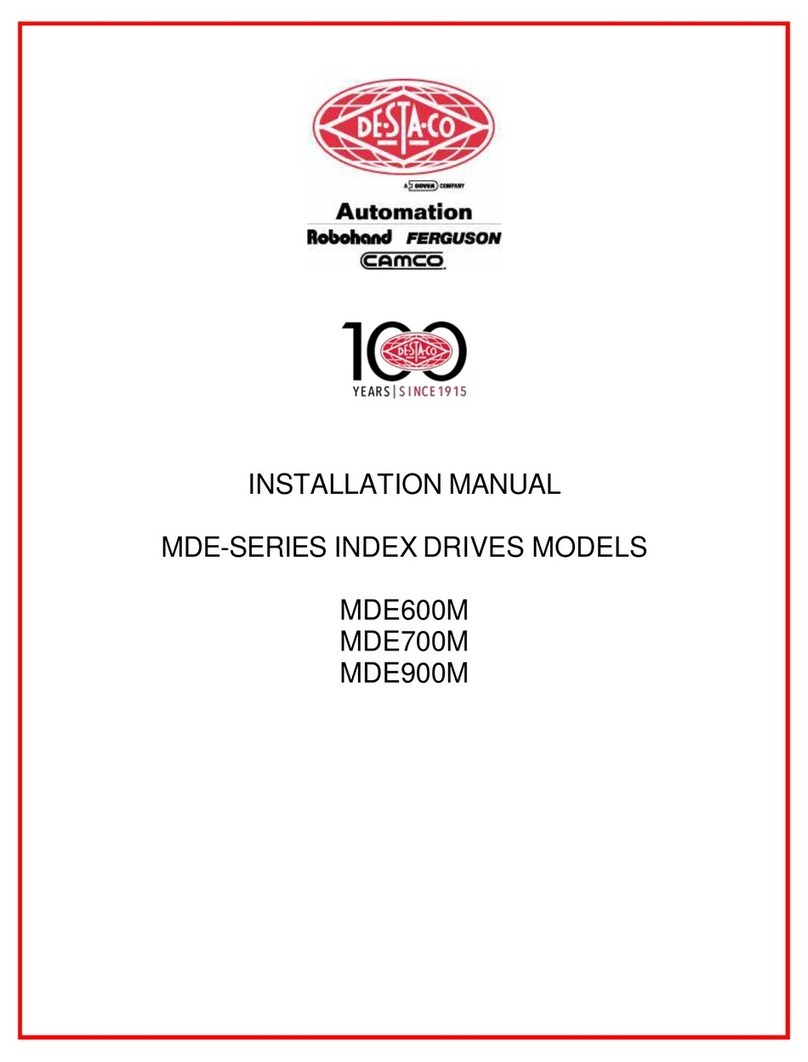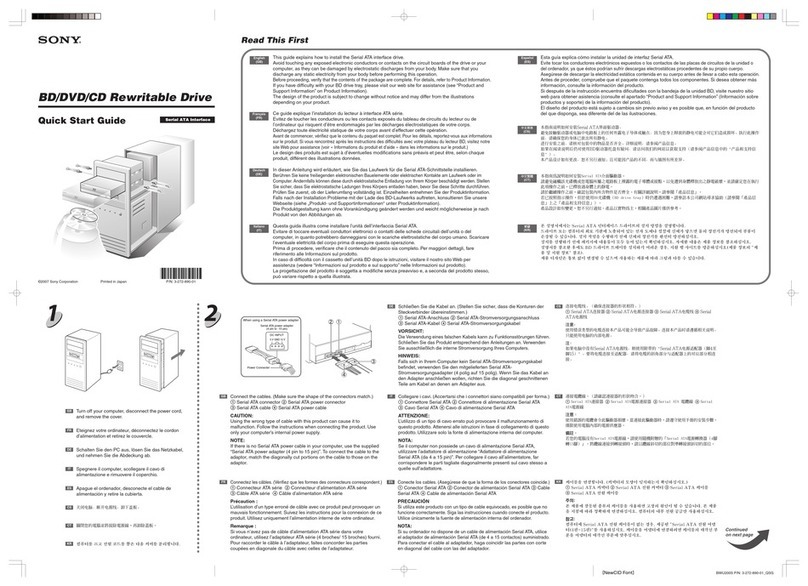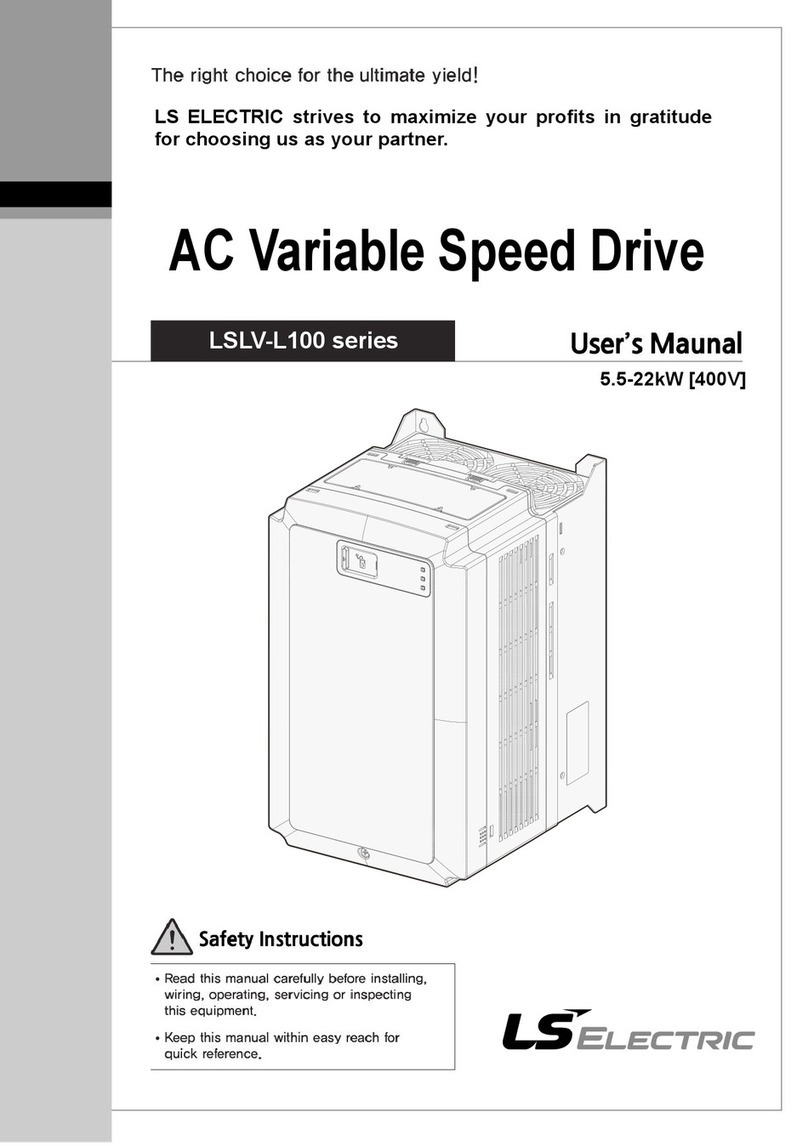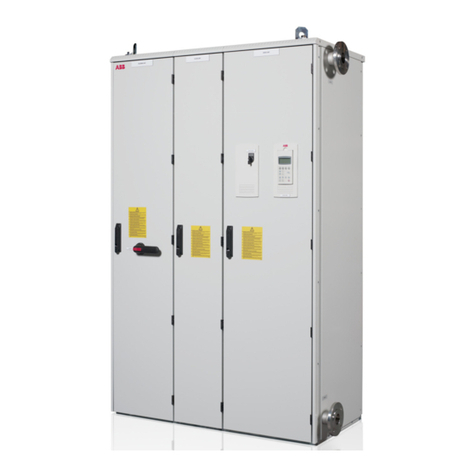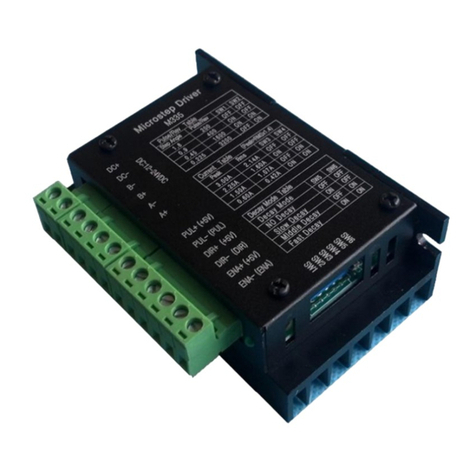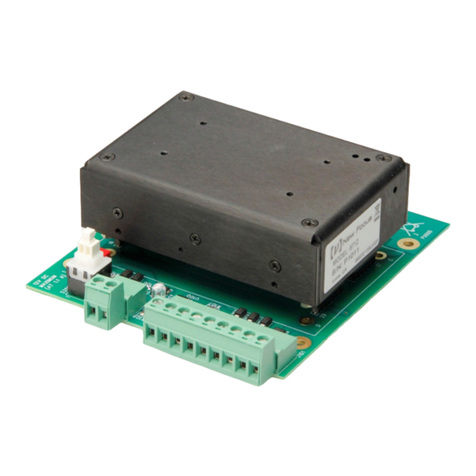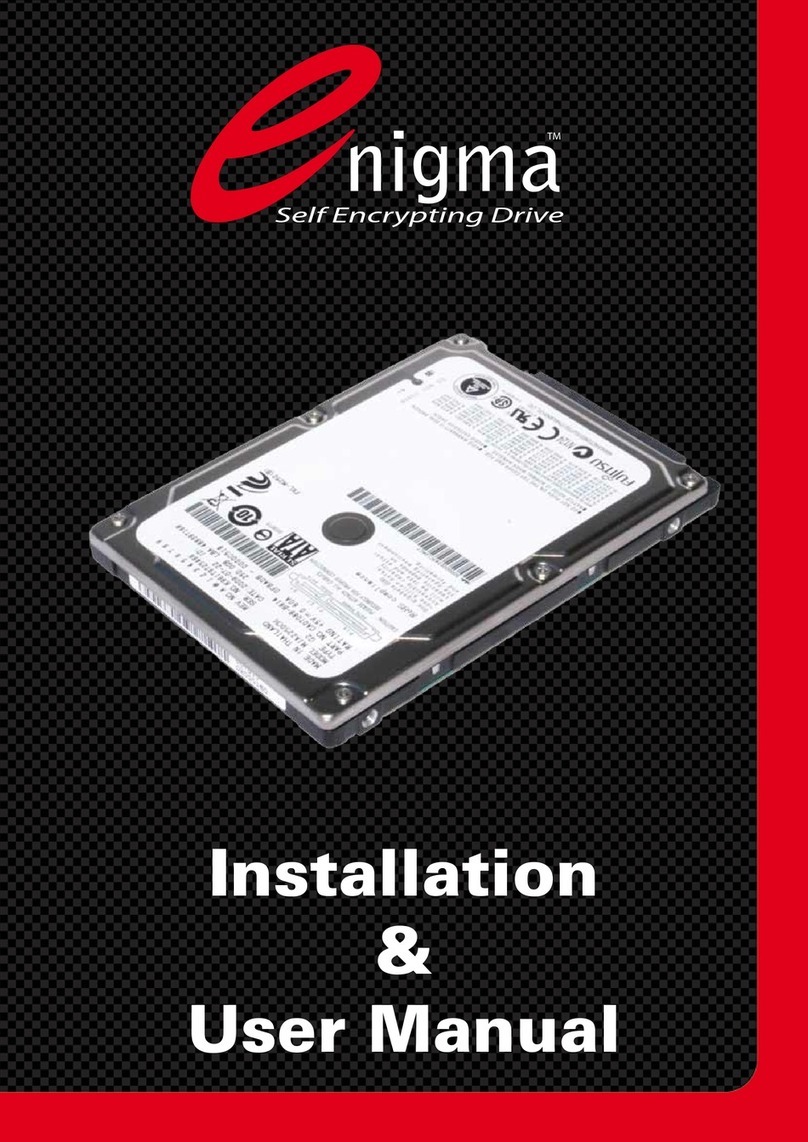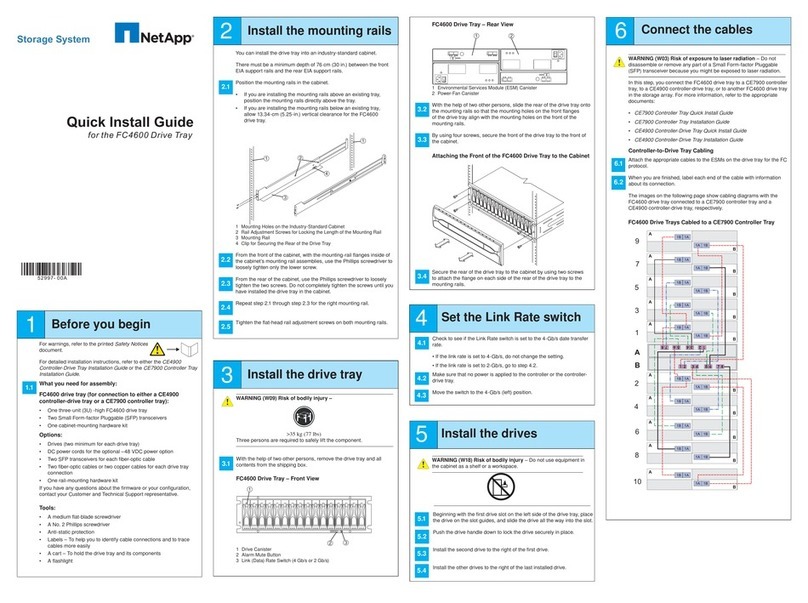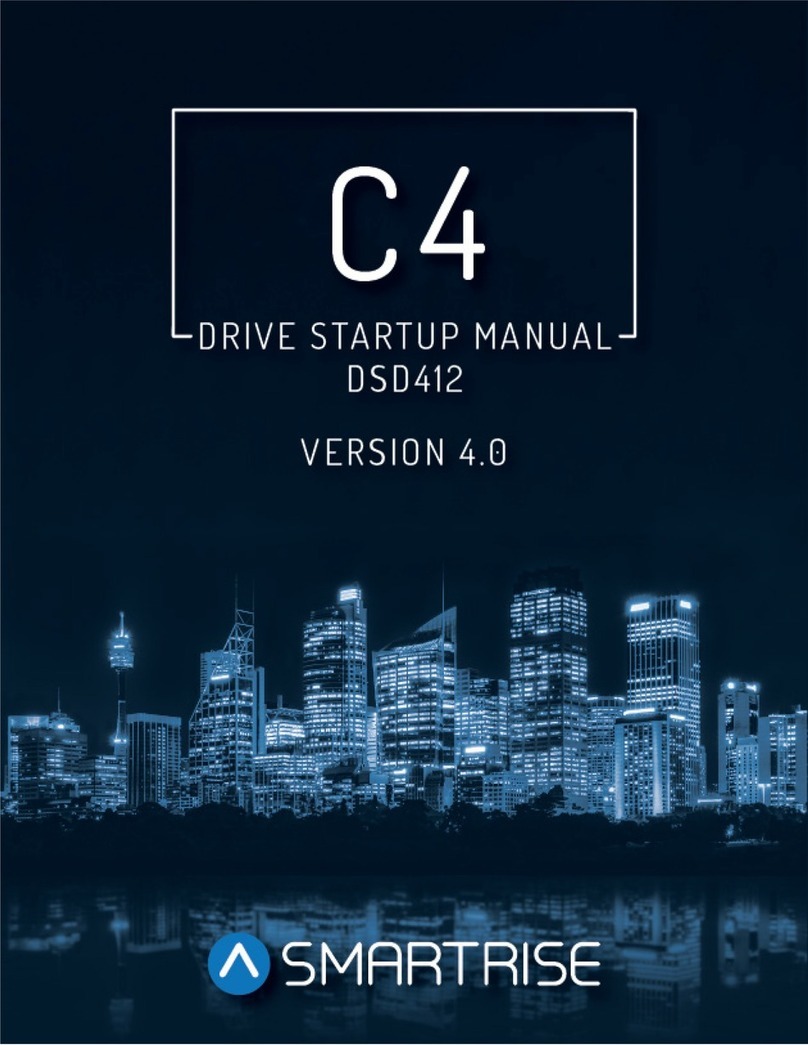WEG CFW-11 Series User manual

Motors | Automation | Energy | Transmission & Distribution | Coatings
EtherCAT
CFW11
User’s Guide

EtherCAT User’s Guide
Series: CFW11
Language: English
Document: 10006412842 / 00
Build 750
Publication Date: 03/2019

Contents
CONTENTS
ABOUT THE MANUAL ..................................................................................... 4
1 Equipment Characteristics in EtherCAT Network .................................. 5
2 EtherCAT Overview ................................................................................... 6
2.1 EtherCAT Technology ..................................................................................... 6
2.2 Device Profiles ............................................................................................. 6
3 Interfaces Description ............................................................................... 7
3.1 EtherCAT Interface Accessory .......................................................................... 7
3.2 Connectors ................................................................................................. 7
3.3 Indication LEDs ............................ ................................................................ 7
4 Network Installation .................................................................................. 9
4.1 Cable ........................................................................................................ 9
4.2 Network Topology ......................................................................................... 9
4.3 Recommendations for Grounding Connection and Cable Routing ................................ 9
5 Parameterization ....................................................................................... 11
5.1 Symbols for the Properties Description .............................................. .................. 11
P0105 – 1st/2nd ramp selection ................................................................................ 11
P0220 – Local/REMOTE Selection Source .................................................................... 11
P0221 – Speed Reference Selection – LOCAL Situation .................................................... 11
P0222 – Speed Reference Selection – REMOTE Situation .................................................. 11
P0223 – FORWARD/REVERSE Selection – LOCAL Situation ............................................... 11
P0224 – Run/Stop Selection – LOCAL Situation .............................................................. 11
P0225 – JOG Selection – LOCAL Situation .................................................................... 11
P0226 – FORWARD/REVERSE Selection – REMOTE Situation............................................. 11
P0227 – Run/Stop Selection – REMOTE Situation ........................................................... 11
P0228 – JOG Selection – REMOTE Situation ................................................................. 11
P0313 – Action in Case of Communication Error (Fieldbus) ................................................ 11
P0680 – Status Word ............................................................................................. 12
P0681 – Motor Speed in 13 Bits ................................................................................. 13
P0684 – Control Word ............................................................................................ 14
P0685 – Speed Reference .................................................................................. ..... 14
P0695 – Digital Outputs Setting ................................................................. ................ 15
P0696 - Value 1 for Analog Outputs ................................................................ ............ 15
P0697 - Value 2 for Analog Outputs ................................................................ ............ 15
P0698 - Value 3 for Analog Outputs ................................................................ ............ 15
P0699 - Value 4 for Analog Outputs ........................................................................... 15
P0850 – Firmware Revision for EtherCAT Accessory ........................................................ 16
P0851 – EtherCAT Accessory Status ........................................................................... 16
P0852 – EtherCAT Link Status .................................................................................. 17
P0853 – EtherCAT Slave Status ................................................................................. 18
P0855 – Configured TxPDO...................................................................................... 18
P0856 – Number of Bytes Configured at TxPDO ............................................................. 18
P0857 – Configured RxPDO ................................................................ ..................... 19
P0858 – Number of Bytes Configured at RxPDO ............................................................. 19

Contents
P0859 – Data Update Interval ................................................................................... 19
6 Network Operation ......................................................................... ........... 20
6.1 EtherCAT Communication Architecture ................................................................ 20
6.2 EtherCAT State Machine ................................................................................. 20
6.3 Sync Managers ............................................................................................ 21
6.4 Synchronization modes ................................................................ ................... 22
6.5 Process Data - PDO ....................................................................................... 22
6.5.1 PDOs Mapping ..................................................................................... 22
6.5.2 PDO Assignment .................................................................................. 23
6.6 Mailbox ...................................................................................................... 23
6.7 EtherCAT Slave Information ............................................................................. 23
7 Object Dictionary ....................................................................................... 24
7.1 Manufacturer Specific .................................................................................... 24
7.2 Device Profile .............................................................................................. 25
8 CiA 402 Drive Profile .................................................................................. 26
8.1 Device Control ............................................................................................. 26
8.1.1 Object 6040h – Controlword ............................ ......................................... 28
8.1.2 Object 6041h – Statusword ...................................................................... 29
8.1.3 Object 6060h – Modes of Operation ............................................................ 29
8.1.4 Object 6061h – Modes of Operation Display .................................................. 29
8.2 Position Control Function ................................................................................ 30
8.2.1 Object 6063h – Position internal actual value .............................................. ... 30
8.3 Velocity mode .............................................................................................. 30
8.3.1 Control and Status Bits .......................................................................... . 30
8.3.2 Object 6042h – vl target velocity ................................................................ 31
8.3.3 Object 6043h – vl velocity demand ............................................................. 31
8.3.4 Object 6044h – vl control effort .................................................................. 31
8.3.5 Object 6046h – vl velocity min max amount ................................................... 31
8.3.6 Object 6048h – vl velocity acceleration ........................................................ 31
8.3.7 Object 6049h – vl velocity deceleration ........................................................ 32
9 Startup Guide ............................................................................................. 33
9.1 Installing the EtherCAT Module ......................................................................... 33
9.2 Configuring the Drive ..................................................................................... 33
9.3 Configuring the Master ....................................................... ............................ 33
9.4 Communication Status ................................................................................... 34
9.5 Operation Using Process Data .......................................................................... 34
10 Faults and Alarms ...................................................................................... 35
A0145/F0245 - EtherCAT interface access error ............................................................. 35
A0146/F0246 - EtherCAT Offline ................................................................................ 35

ABOUT THE MANUAL
ABOUT THE MANUAL
This manual supplies the necessary information for the operation of the CFW11 frequency inverter using the EtherCAT
protocol. This manual must be used together with the CFW11 user’s manual and programming manual.
✓NOTE!
To use the EtherCAT accessory for CFW11 frequency inverter, it is necessary to use the special
version 5.5X. This version was designed based on standard version 5.10.
During power on, due to the initialization time required for EtherCAT interface, the CFW11 frequency
inverter may be momentarily unresponsive, and a loss of communication message may be displayed
on the keypad.
CFW11 | 5

Equipment Characteristics in EtherCAT Network
1 EQUIPMENT CHARACTERISTICS IN ETHERCAT NETWORK
Following they are presented the main characteristics for the EtherCAT communication accessory for CFW11
frequency inverter.
It allows the equipment to operate as slave for the EtherCAT communication.
It has two Ethernet ports, which allows to connect several equipments in sequence or in a ring topology.
It uses CoE (CANopen over EtherCAT) protocol in the application layer.
It makes available several objects according to CiA 402 specification - Device Profile Drives and Motion Control.
There is a xml file that is supplied with the product to configure the network master.
CFW11 | 6

EtherCAT Overview
2 ETHERCAT OVERVIEW
Following it is presented general information about the EtherCAT tecnology.
2.1 ETHERCAT TECHNOLOGY
EtherCAT (Ethernet for Control Automation Technology) is a Real Time Ethernet technology introduced originally in
2003 by Beckhoff. In 2007, it was integrated into the international fieldbus standards IEC 61158. The EtherCAT
Technology Group (ETG) promotes EtherCAT and is responsible for its continued development.
EtherCAT communication technology is based on 100BASE-TX Ethernet physical layer. An EtherCAT bus consists
of a master system and up to 65535 slave devices, connected together with standard Ethernet cabling.
In order to improve network performance, instead of sending one Ethernet package at a time to each node, EtherCAT
network takes a different approach, employing ”on the fly” processing hardware. The frame, containing data to several
slaves, is initially sent by the master to the first slave on the network. The slave device process the incoming Ethernet
frames directly, extract or insert relevant data and transfer the frame to the next EtherCAT slave device, without
waiting the entire frame to be received. The last slave device in the bus segment sends the fully processed frame
back, so that it is returned by the first slave to the master as a kind of response frame, which maximize the use of
the full duplex Ethernet bandwidth. This approach makes data update between master and slaves really fast and
deterministic, ideal for application fields like machine controls.
2.2 DEVICE PROFILES
The EtherCAT communication allows different protocols to be used in the application layer. For frequency inverter
CFW11, the CANopen over EtherCAT (CoE) device profile is available, where the CANopen protocol is applied to
EtherCAT. Different communication objects available to CANopen are also used via EtherCAT, like Service Data
Objects (SDO), Process Data Objects (PDO) and the Object Dictionary structure to manage the parameters.
CFW11 | 7

Interfaces Description
3 INTERFACES DESCRIPTION
CFW11 frequency inverter uses EtherCAT accessory connected to slot 3 to provide an EtherCAT interface operating
as EtherCAT slave in the product.
3.1 ETHERCAT INTERFACE ACCESSORY
Supplied items:
–Installation guide.
–EtherCAT interface module.
It has an integrated switch to daisy chain connection.
3.2 CONNECTORS
Two RJ45 connectors are available for network connection:
XC1 (IN): used to connect to the segment that comes from master side.
XC2 (OUT): used to connect to the segment that leads to the other slaves (or not connected, if it is the last device
on the network).
Figure 3.1: Connectors and LEDs of EtherCAT accessory
The connectors pinout follows the Fast Ethernet 100BASE-TX standard, using two pairs of cables (standard
connection, straight-through) for transmitting and receiving data.
EtherCAT accessory makes the protective earth connection through the fixing screw. The connectors frame, which
are usually connected to the cable shield, are short circuited, and a RC circuit connects them to the protective earth.
3.3 INDICATION LEDS
EtherCAT accessory has a LED indicator on each Ethernet port, and a bicolor LED for diagnostics (Status). These
LEDs have the following functions and indications:
Table 3.1: EtherCAT indication LEDs
LED Color Function
Link/Activity
(IN/OUT)
Green Indication of link and activity, one for each Ethernet port.
Status Bicolor
(Green/Red)
Module state; indicate the state of EtherCAT slave.
CFW11 | 8

Interfaces Description
Table 3.2: Link/Activity LED
State Description
Off No link or equipment not powered.
Solid green With link, no activity.
Blinking With link and with activity.
Table 3.3: Status LED
Color State Description
Green
Off INIT (or not powered)
Alternating on/off PRE-OPERATIONAL.
1 blink and 1 interval SAFE-OPERATIONAL.
Solid green OPERATIONAL.
Red Off No error (or not powered)
Alternating on/off Interface initialization error.
CFW11 | 9

Network Installation
4 NETWORK INSTALLATION
Following are recommendations related to equipment installation in an EtherCAT network. Details on the characteristics
of the components used for installation can be obtained along the ETG.
4.1 CABLE
Recommended characteristics for the cable:
Standard Ethernet cable, 100Base-TX (FastEthernet), CAT 5e.
Shielded cable.
Maximum length between devices: 100m.
4.2 NETWORK TOPOLOGY
To connect CFW11 frequency inverter in an EtherCAT network, it is necessary to observe the Ethernet connector on
the device used for connection.
The network always start by the EtherCAT master.
The X1 connector (IN) should always be connected to the network segment leading to the EtherCAT master.
The X2 connector (OUT) should always be connected to the network segment leading to other EtherCAT slaves.
When connected in a ring topology for redundancy, the X2 connector (OUT) of the last slave can be connected
to the second port of the EtherCAT master, otherwise it should be leave disconnected.
Figure 4.1: EtherCAT network topology
4.3 RECOMMENDATIONS FOR GROUNDING CONNECTION AND CABLE ROUTING
The correct connection with the ground decreases problems caused by interference in an industrial environment. The
following are some recommendations about grounding and cable routing:
Always use shielded twisted pair Ethernet cables and connectors with metallic casing.
CFW11 | 10

Network Installation
Use clamps on the main grounding point, allowing better contact surface between the cable shield and ground.
Avoid the cable connection on multiple grounding points, especially where there are grounds with different
potentials.
Pass signal cables and communication cable in dedicated pathways. Prevent the passage of these cables next
to power cables.
CFW11 | 11

Parameterization
5 PARAMETERIZATION
Next, the CFW11 frequency inverter parameters related to the EtherCAT communication will be presented.
5.1 SYMBOLS FOR THE PROPERTIES DESCRIPTION
RO Read-only parameter
RW Read/write parameter
CFG Parameter that can be changed only with a stopped motor
ECAT Parameter visible on the HMI if the product has the EtherCAT interface installed
P0105 – 1ST/2ND RAMP SELECTION
P0220 – LOCAL/REMOTE SELECTION SOURCE
P0221 – SPEED REFERENCE SELECTION – LOCAL SITUATION
P0222 – SPEED REFERENCE SELECTION – REMOTE SITUATION
P0223 – FORWARD/REVERSE SELECTION – LOCAL SITUATION
P0224 – RUN/STOP SELECTION – LOCAL SITUATION
P0225 – JOG SELECTION – LOCAL SITUATION
P0226 – FORWARD/REVERSE SELECTION – REMOTE SITUATION
P0227 – RUN/STOP SELECTION – REMOTE SITUATION
P0228 – JOG SELECTION – REMOTE SITUATION
Description:
These parameters are used to configure the command sources for CFW11 frequency inverter local and remote
situations. To control the device through the EtherCAT interface, select the options ‘EtherCAT’ available in these
parameters.
The detailed description of these parameters is found in the CFW11 programming manual.
P0313 – ACTION IN CASE OF COMMUNICATION ERROR (FIELDBUS)
Range: 0 = Inactive
1 = Disable via Run/Stop
2 = Disable via General Enable
3 = Change to Local
4 = Change to Local keeping commands and reference
5 = Causes a Fault
Default: 1
Properties: CFG
Description:
CFW11 | 12

Parameterization
It allows the selection of the action performed by the device, if it is controlled via network and detects a communication
error.
Table 5.1: P0313 options
Options Description
0 = Inactive It takes no action and the device remains in the existing status.
1 = Disable via Run/Stop It performs a stop command and the motor stops according to the programmed
deceleration ramp.
2 = Disable via General
Enable
The device is disabled by removing the General Enabling and the motor coasts to stop.
3 = Change to Local The device commands change to Local.
4 = Change to Local keeping
commands and reference
The device commands change to Local, but the enabling commands and speed
reference received via network are kept, if the device has been programmed to use,
in Local mode, the commands via HMI or 3-wire start/stop, and speed reference via
either HMI or electronic potentiometer.
5 = Causes a Fault Instead of an alarm, the communication error causes a device fault, so that a fault reset
becomes necessary in order to restore normal operation.
The device consider the following events as communication errors:
Alarm A145/Fault F245: erro de acesso à interface EtherCAT.
Alarm A146/Fault F246: EtherCAT offline.
The actions described in this parameter are done by means of the automatic writing of the selected actions in the
respective bits of the interface control words. Therefore, in order that the commands written in this parameter be
effective, it is necessary that the device be programmed to be controlled via the used network interface (with exception
of option “Causes a Fault”, which blocks the equipment even if it is not controlled by network). This programming is
achieved by means of parameters P0220 to P0228.
P0680 – STATUS WORD
Range: 0000h ... FFFFh Default: -
Properties: RO
Description:
It allows the device status monitoring. Each bit represents a specific status:
Bit 15 14 13 12 11 10 9 8 7 6 5 4 3 2 1 0
Function
Fault condition
Automatic (PID)
Undervoltage
LOC/REM
JOG
Speed direction
General enable active
Motor Running
Alarm condition
In configuration mode
Second ramp
Quick stop active
Reserved
CFW11 | 13

Parameterization
Table 5.2: P0680 parameter bit functions
Bit Value/Description
Bit 0 ... 3 Reserved
Bit 4
Quick stop active
0: The quick stop command is not active.
1: The drive is executing the quick stop command.
Bit 5
Second ramp
0: The drive is configured to use the first ramp values, programmed in P0100 and P0101, as the motor
acceleration and deceleration ramp times.
1: The drive is configured to use the second ramp values, programmed in P0102 and P0103, as the motor
acceleration and deceleration ramp times.
Bit 6
In configuration mode
0: The drive is operating normally.
1: The drive is in the configuration mode. It indicates a special condition during which the drive cannot be
enabled:
Running the self-tuning routine.
Running the oriented start-up routine.
Running the HMI copy function.
Running the flash memory card self-guided routine.
There is a parameter setting incompatibility.
There is no power at the device power section.
Bit 7
Alarm condition
0: The drive is not in alarm condition.
1: The drive is in alarm condition.
Bit 8
Motor Running
0: The motor is stopped (or coast to stop).
1: The drive is running the motor at the set point speed, or executing either the acceleration or the deceleration
ramp.
Bit 9
General enable active
0: General Enable is not active.
1: General Enable is active and the drive is ready to run the motor.
Bit 10
Speed direction
0: The motor is running in the reverse direction.
1: The motor is running in the forward direction.
Bit 11
JOG
0: JOG function disabled.
1: JOG function enabled.
Bit 12
LOC/REM
0: Drive in Local mode.
1: Drive in Remote mode.
Bit 13
Undervoltage
0: No Undervoltage.
1: With Undervoltage.
Bit 14
Automatic (PID)
0: PID in manual mode.
1: PID in Automatic mode.
Bit 15
Fault condition
0: The drive is not in a fault condition.
1: The drive has detected a fault.
P0681 – MOTOR SPEED IN 13 BITS
Range: -32768 ... 32767 Default: -
Properties: RO
Description:
It allows monitoring the motor speed. This word uses 13-bit resolution with signal to represent the motor synchronous
speed:
P0681 = 0000h (0 decimal) →motor speed = 0
P0681 = 2000h (8192 decimal) →motor speed = synchronous speed
Intermediate or higher speed values can be obtained by using this scale. E.g., for a 4 pole motor and 1800 rpm of
synchronous speed, if the value read is 2048 (0800h), then, to obtain the speed in rpm one must calculate:
8192 ⇒1800 rpm
2048 ⇒Speed
Speed = 2048 ×1800
8192
Speed = 450 rpm
Negative values in this parameter indicate that the motor is running in the reverse direction.
CFW11 | 14

Parameterization
P0684 – CONTROL WORD
Range: 0000h ... FFFFh Default: 0000h
Properties: RW
Description:
It is the EtherCAT interface control word. This parameter can only be changed via EtherCAT interface. For the other
sources (HMI, etc.) it behaves like a read-only parameter.
In order to control the device using those commands, it is necessary to program the equipment to be controlled via
EtherCAT. This programming is achieved by means of parameters P0105 and P0220 to P0228.
Each bit of this word represents a command.
Bit 15 14 13 12 11 10 9 8 7 6 5 4 3 2 1 0
Function
Reserved
Fault reset
Quick stop
Second ramp
LOC/REM
JOG
Speed direction
General enable
Stop/Run
Table 5.3: Bit function for parameter P0684
Bit Value/Function
Bit 0
Stop/Run
0: It stops the motor with deceleration ramp.
1: The motor runs according to the acceleration ramp.
Bit 1
General enable
0: It disables the drive, interrupting the supply for the motor.
1: It enables the drive allowing the motor operation.
Bit 2
Speed direction
0: Direction of rotation is opposed to the speed reference (reverse).
1: Direction of rotation is the same as the speed reference (direct).
Bit 3
JOG
0: It disables the JOG function.
1: It enables the JOG function.
Bit 4
LOC/REM
0: The drive goes to the Local mode.
1: The drive goes to the Remote mode.
Bit 5
Second ramp
0: The drive uses the first ramp values, programmed in P0100 and P0101, as the motor acceleration and
deceleration ramp times.
1: The drive is configured to use the second ramp values, programmed in P0102 and P0103, as the motor
acceleration and deceleration ramp times.
Bit 6
Quick stop
0: It does not execute the quick stop command.
1: It executes the quick stop command.
Bit 7
Fault reset
0: No function.
1: If in a fault condition, then it executes the fault reset.
Bit 8...15 Reserved
P0685 – SPEED REFERENCE
Range: -32768 ... 32767 Default: 0
Properties: RW
Description:
It is the EtherCAT interface motor speed reference. This parameter can only be changed via EtherCAT interface. For
the other sources (HMI, etc.) it behaves like a read-only parameter.
To use the reference written in this parameter, it is necessary to program the drive to use the speed reference via
EtherCAT. This programming is achieved by means of parameters P0221 and P0222.
This word uses a 13-bit resolution with signal to represent the motor synchronous speed:
CFW11 | 15

Parameterization
P0685 = 0000h (0 decimal) →speed reference = 0
P0685 = 2000h (8192 decimal) →speed reference = synchronous speed
Intermediate or higher reference values can be programmed by using this scale. E.g. for a 4 pole motor and 1800
rpm of synchronous speed, to obtain a reference of 900 rpm, one must calculate:
1800 rpm ⇒8192
900 rpm ⇒Reference in 13 bits
Reference in 13 bits = 900 ×8192
1800
Reference in 13 bits = 4096 ⇒Value corresponding to 900 rpm in a 13 bit scale
This parameter also accepts negative values to revert the motor speed direction. The speed reference direction,
however, depends also on the bit 2 of control word:
Bit 2 = 1 and P0685 > 0: forward direction of rotation
Bit 2 = 1 and P0685 < 0: reverse direction of rotation
Bit 2 = 0 and P0685 > 0: reverse direction of rotation
Bit 2 = 0 and P0685 < 0: forward direction of rotation
P0695 – DIGITAL OUTPUTS SETTING
Range: 00000b... 11111b Default: 00000b
Properties: RW
Description:
It allows the control of the digital outputs by means of the network interfaces (EtherCAT, etc.). It is not possible to
change this parameter via HMI.
Each bit of this parameter corresponds to the desired value for one digital output. In order to control the correspondent
digital output according to this content, it is necessary that its function be programmed for “P0695 Content” at
parameters to program digital outputs function.
Bit 15 14 13 12 11 10 9 8 7 6 5 4 3 2 1 0
Function
Reserved
Value for DO5
Value for DO4
Value for DO3
Value for DO2
Value for DO1
Table 5.4: Bit function for parameter P0695
Bit Valor/Descrição
Bit 0
Value for DO1
0: Open DO1.
1: Close DO1.
Bit 1
Value for DO2
0: Open DO2.
1: Close DO2.
Bit 2
Value for DO3
0: Open DO3 .
1: Close DO3.
Bit 3
Value for DO4
0: Open DO4.
1: Close DO4.
Bit 4
Value for DO5
0: Open DO5.
1: Close DO5.
Bit 5...15 Reserved.
CFW11 | 16

Parameterization
P0696 - VALUE 1 FOR ANALOG OUTPUTS
P0697 - VALUE 2 FOR ANALOG OUTPUTS
P0698 - VALUE 3 FOR ANALOG OUTPUTS
P0699 - VALUE 4 FOR ANALOG OUTPUTS
Range: -32768 ... 32767 Default: 0
Properties: RW
Description:
They allow the control of the analog outputs by means of network interfaces (EtherCAT, etc.). It is not possible to
change this parameter via HMI.
The value written in these parameters may control the analog output value, as long as you program the option “P0696
... P0699 value” at the analog output function parameters.
The value must be written in a 15-bit1scale (7FFFh = 32767) to represent 100 % of the output desired value, i.e.:
P0696 = 0000h (0 decimal) →analog output value = 0 %
P0696 = 7FFFh (32767 decimal) →analog output value = 100 %
The showed example was for P0696, but the same scale is also used for the other parameters. For instance, to
control the analog output 1 via EtherCAT, the following programming must be done:
Choose a parameter from P0696 ... P0699 to be the value used by the analog output 1. For this example, we
are going to select P0696.
Program the option “P0696 value” as the function for the analog output 1 in P0254.
Using the network interface, write in P0696 the desired value for the analog output 1, between 0 and 100 %,
according to the parameter scale.
✓NOTE!
If the analog output is programmed for working from -10 V to 10 V, negative values for this parameter
must be used to command the output with negative voltage values, i.e., -32768 to 32767 represent a
variation from -10 V to 10 V at the analog output.
P0850 – FIRMWARE REVISION FOR ETHERCAT ACCESSORY
Range: 0 a 65535 Default: -
Properties: ro, ecat
Description:
EtherCAT accessory has an internal processor responsible by running the communication routines and perform data
exchange with CFW11 frequency inverter. This parameter identify the firmware revision of this accessory.
1For the actual output resolution, refer to the product manual.
CFW11 | 17

Parameterization
P0851 – ETHERCAT ACCESSORY STATUS
Range: 0 = Inactive
1 = Access error
2 = Watchdog error
3 = Offline
4 = Online
Default: -
Properties: ro, ecat
Description:
Indicates the status of EtherCAT Interface, related to the data exchange between network master and CFW11
frequency inverter.
Table 5.5: Indications of parameter P0851
Value Description
0 = Inactive Interface not installed or not recognized by the device.
1 = Access error Error during the initialization procedure of EtherCAT module.
2 = Watchdog error Error in the watchdog mechanism between accessory and device, responsible by
checking if data update between both are running successfully.
3 = Offline EtherCAT module running properly, but there is no cyclic data exchange with the network
master.
4 = Online EtherCAT module running properly, with cyclic data exchange with the network master.
P0852 – ETHERCAT LINK STATUS
Range: 0000h ... FFFFh Default: -
Properties: ro, ecat
Description:
Parameter that provides information about the state of communication for each available Ethernet port on the module.
Uses a binary field, where each bit represents a different information:
Bit 15 14 13 12 11 10 9 8 7 6 5 4 3 2 1 0
Function
Reserved
Port 2: Communication
Established
Port 2: Loop Active
Port 1: Communication
Established
Port 1: Loop Active
Reserved
Link 2 OK
Link 1 OK
Reserved
CFW11 | 18

Parameterization
Table 5.6: P0852 bits indication
Bit Value/Description
Bit 0...3 Reserved.
Bit 4
Link 1 OK
0: Port 1: No link.
1: Port 1: Link active.
Bit 5
Link 2 OK
0: Port 2: No link.
1: Port 2: Link active.
Bit 6...7 Reserved.
Bit 8
Port 1: Loop active
0: Port 1: No loop.
1: Data loop active at port 1, to return response to the master.
Bit 9
Port 1: Communication
Established
0: No communication at port 1.
1: Communication established at port 1.
Bit 10
Port 2: Loop active
0: Port 2: No loop.
1: Data loop active at port 2, to return response to the master.
Bit 11
Port 2: Communication
Established
0: No communication at port 2.
1: Communication established at port 2.
Bit 12...15 Reserved.
P0853 – ETHERCAT SLAVE STATUS
Range: 0 = Inactive
1 = Initialization
2 = Pre-operational
3 = Reserved
4 = Safe-operational
5 = Reserved
6 = Reserved
7 = Reserved
8 = Operational
Default: -
Properties: ro, ecat
Description:
Indicate the slave state, according to the EtherCAT state machine.
Table 5.7: Indications of parameter P0853
Valor Descrição
0 = Inactive Interface is inactive.
1 = Initialization EtherCAT in the initialization state, waiting configurations and commands from the
master to allow data exchange via mailbox.
2 = Pre-operational Initialization successful, waiting commands from the master to configure the
communication and starting cyclic data exchange.
4 = Safe-operational Master starts cyclic data reading, but data writing is not performed.
8 = Operational Mastes runs cyclic data update for reading and writing data areas.
P0855 – CONFIGURED TXPDO
Range: 0 to 65535 Default: -
Properties: ro, ecat
Description:
Indicates the index of the transmission PDO selected for communicate with the equipment. The device has 4 transmit
PDOs, responsible for sending data to the master, but only one can be active for communication. Each TxPDO has
a default mapping, but the master can also change the PDO mapping as desired.
CFW11 | 19

Parameterization
P0856 – NUMBER OF BYTES CONFIGURED AT TXPDO
Range: 1 to 32 Default: -
Properties: ro, ecat
Description:
Indicates the data size, in bytes, transmitted to the master via the TxPDO. The number of bytes is formed by adding
the size of each object mapped in TxPDO and is updated only when the master initiates the cyclic data communication
with the equipment.
P0857 – CONFIGURED RXPDO
Range: 0 to 65535 Default: -
Properties: ro, ecat
Description:
Indicates the index of the receive PDO selected for communicate with the equipment. The device has 4 receive
PDOs, responsible for receiving data from the master, but only one can be active for communication. Each RxPDO
has a default mapping, but the master can also change the PDO mapping as desired.
P0858 – NUMBER OF BYTES CONFIGURED AT RXPDO
Range: 1 to 32 Default: -
Properties: ro, ecat
Description:
Indicates the data size, in bytes, received from the master via the RxPDO. The number of bytes is formed by adding the
size of each object mapped in RxPDO and is updated only when the master initiates the cyclic data communication
with the equipment.
P0859 – DATA UPDATE INTERVAL
Range: 0.0 a 1000.0 ms Default: -
Properties: ro, ecat
Description:
Once in the operational state, the master must send telegrams to update the operating data at regular intervals. This
parameter indicates the time between the last two data updates, allowing user to monitor the period for execution of
this function.
CFW11 | 20
Other manuals for CFW-11 Series
19
Table of contents
Other WEG DC Drive manuals
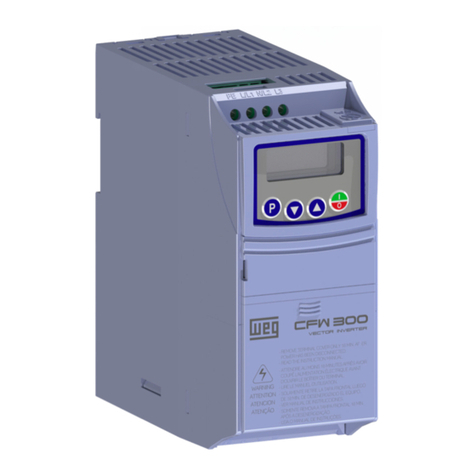
WEG
WEG CFW300 V1.3X Owner's manual
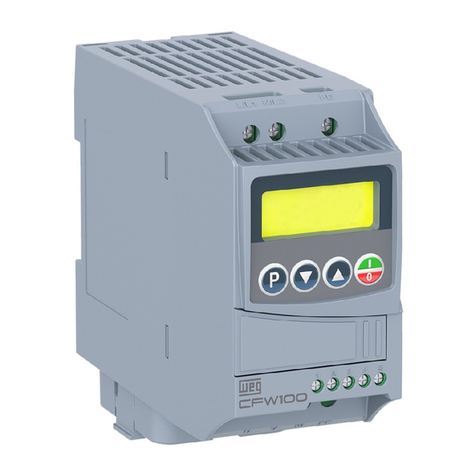
WEG
WEG CFW100 series Owner's manual
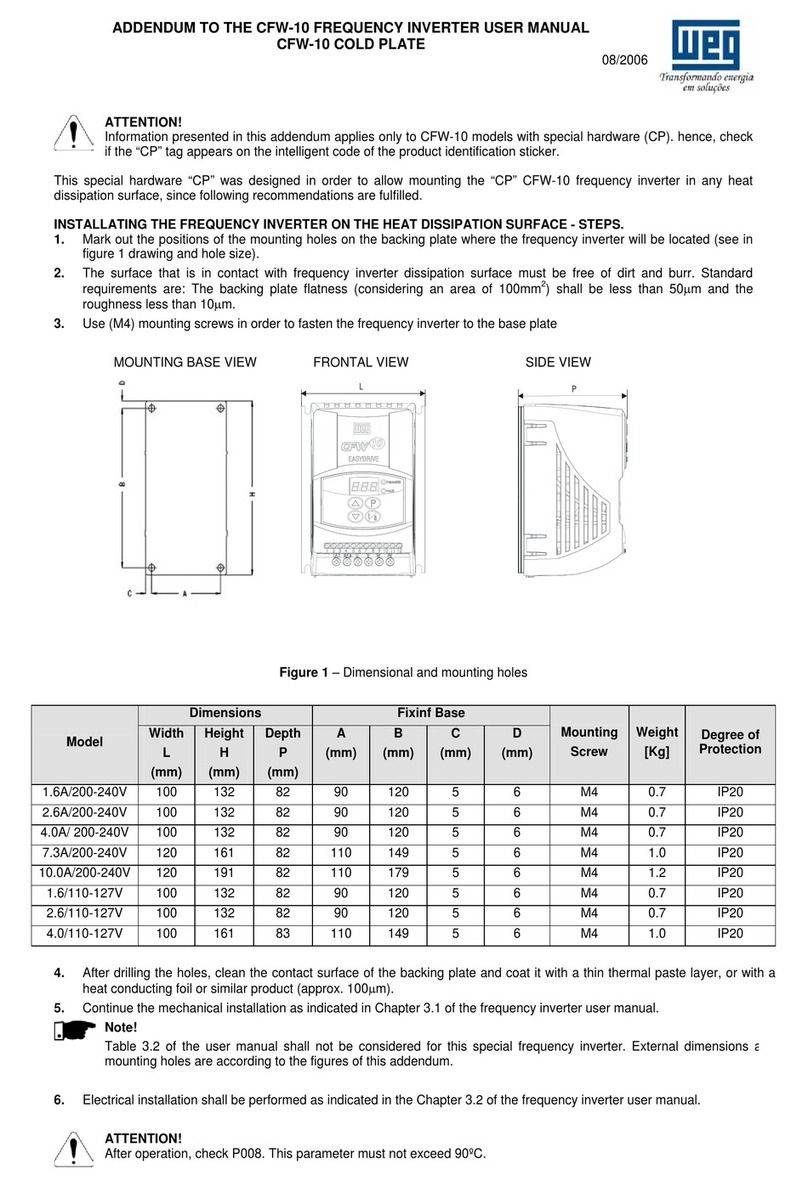
WEG
WEG Easy Drive CFW10 Installation and operating instructions
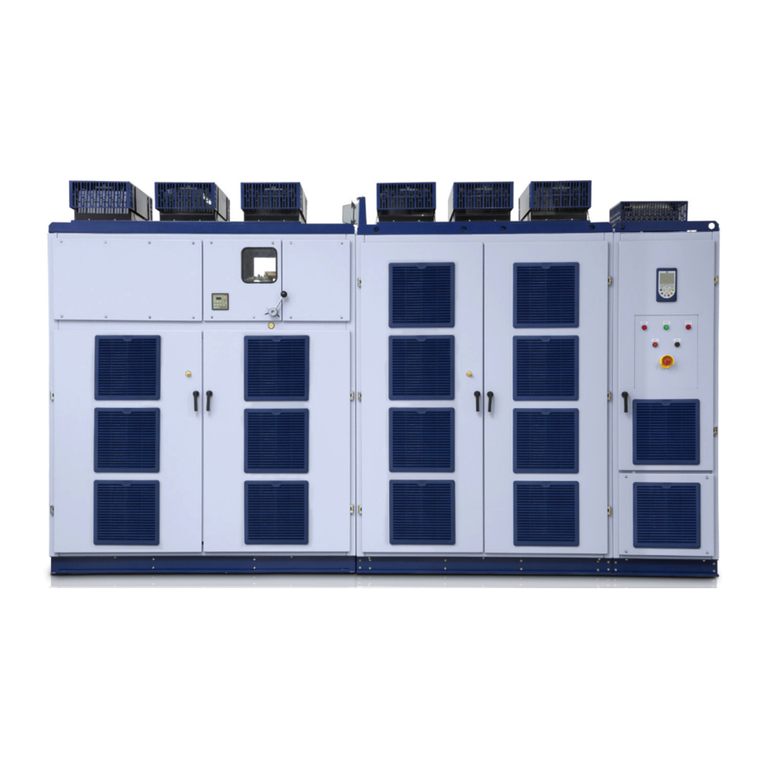
WEG
WEG MVW3000 Series User manual
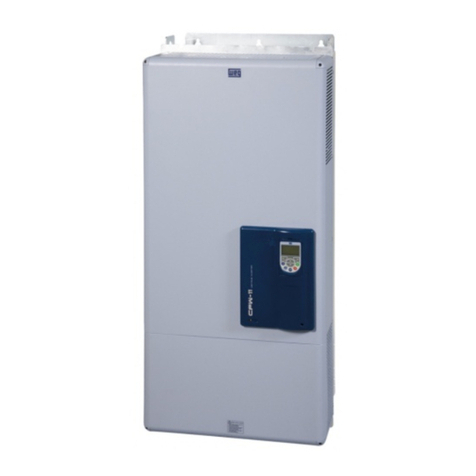
WEG
WEG CFW-11 Series User manual

WEG
WEG CFW-11 Series User manual

WEG
WEG CFW-11M RB User manual

WEG
WEG CFW-11 Series Owner's manual
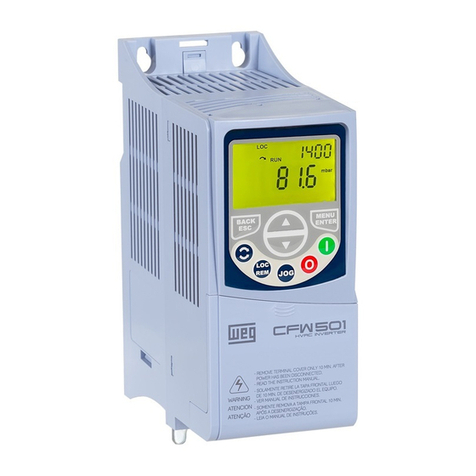
WEG
WEG CFW501 User manual
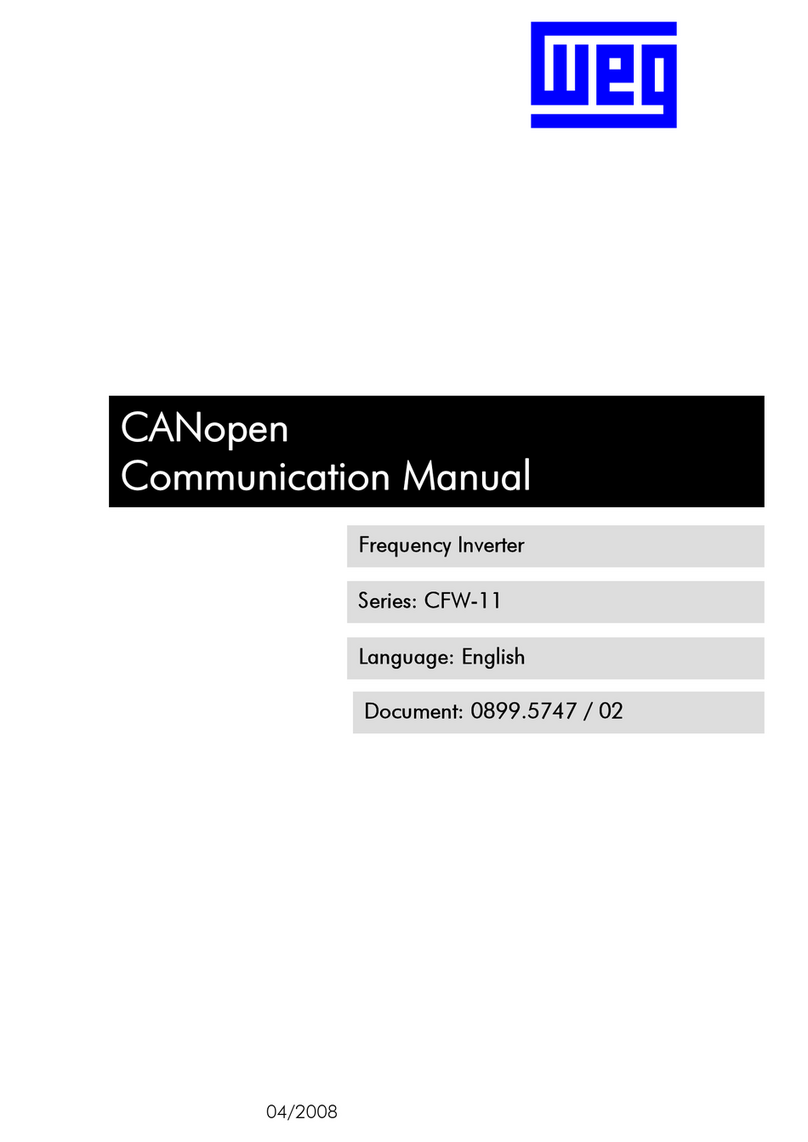
WEG
WEG CFW-11 Series Use and care manual

